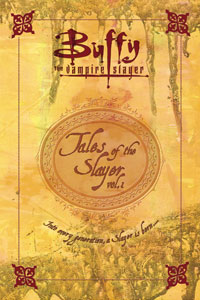I remember when “Tales of the Slayer Vol. 1” (October 2001) came out, it felt to me like for first time the Buffyverse had a sprawling Expanded Universe similar to what “Star Wars” had developed. Starting here, a character need not be peripherally linked to Buffy in order to have their story told.
These seven short stories are about Slayers of all types – granted, all are girls or young women, as per the mythology – throughout history. The tales leave more of an impression as windows into history than into the Slayers themselves, although that’s not necessarily a knock against the book. After all, Buffy’s story is being told because she is the Slayer whose tale is worth telling.
Still, these seven yarns provide a not-so-dry way to learn about civilization’s past. Here are my rankings:
1. “Unholy Madness,” France, 1789, by Nancy Holder – Holder deftly sets the stage of pre-Revolution Paris with corpses left to rot in the streets and waste management that consists of throwing buckets of offal out the window. Then she gets into vibrant social commentary. Our heroes – Slayer Marie-Christine and Watcher Edmund – are representative of the mainstream view: that the divide between ruling class and peasants is a just state of affairs. The Watchers’ Council assigns Slayers to specifically protect royalty; which nation’s royalty depends on political favors. Marie-Christine gradually decides the underclass is worthy of protection from vampires as well, but what’s really daring about Holder’s story is that a vampire leads the people’s revolution.
2. “Die Blutgrafin,” Hungary, 1609, by Yvonne Navarro – Navarro creates a wonderful sense of place as Slayer Ildiko and Watcher Kurt Rendor live in a hovel with a view of the mountain castle whose queen might be a vampire. Ildiko’s infiltration of the castle, where she has landed a job as a servant girl based on her physical strength, is intense and spooky in the Gothic fashion. The ending is powerful in its violence, retroactively lending the entire story a vibe of hopelessness.
3. “The White Doe,” London, 1586, by Christie Golden – Before she became a prolific “Star Wars” EU writer, Golden entered my reading sphere with this tale, which taps into the Roanoke/Croatoan mystery in the early days of American colonization. Golden takes advantage of a mythology element introduced with Kendra on the TV show: that Watchers train Potentials, who are identified via magic, prior to their calling as a Slayer.
Virginia Dare, the first white child born in America, is identified as a Potential even before she is born, so her Watcher, John White, has her well-trained by the time she is called. The Indians know how vampirism works, so they smash the skulls of humans who have drank of the vampires. “The White Doe” is sometimes clunky, but it’s a fun blend of “Buffy” mythology and colonial legend, and it makes me want to consume more Roanoke-based horror yarns.
4. “Silent Screams,” Germany, 1923, by Mel Odom – Set soon after “Nosferatu” became a cinema hit and vampire mythology went mainstream, this story of Slayer Britta and Watcher Friedrich gives away its twist a bit early: that the filmmaker hosting a screening of “Silent Screams” is actually a vampire and that everything in the film is real.

Still, Odom gives the tale momentum by telling it from the point of view of Friedrich, who is frantically putting this down on paper before his inevitable death. The actions in his first major battle as a Watcher are cowardly, rather than heroic, giving this a grim feel similar to “Die Blutgrafin” (although it’s not that dark). Seeing the failure of this Watcher provides a nice contrast to Giles.
5. “Mornglom Dreaming,” Kentucky, 1886, by Doranna Durgin – Slayer Mollie grows up in a tradition-bound community, where people desire nothing more than a good life of working farmland (or perhaps the newfangled coal mines) and having a spouse and kids. The story’s fun comes from seeing these set-in-their-ways folks be flabbergasted not only by the monster in their midst, but also by the young woman who kills the monster.
6. “And White Splits the Night,” Florida, 1956, by Navarro – This is the less interesting of Navarro’s two contributions, as it mixes “Buffy” mythology with the racial strife of the South in heavy-handed fashion. I do enjoy the author’s portrayal of a town in the swamplands of Florida, and the fact that the community has whites, blacks and Cajuns (who I associate more with Louisiana). Slayer Asha, who is black, and Watcher Laurent, who is white, do their work mostly in the swamps before realizing the big problem is right in town: the KKK is vampires.
7. “A Good Run,” Greece, 490 B.C.E., by Greg Rucka – The book’s brisk first entry introduces three themes that every tale taps into. Slayer Thessily helps humanity (specifically the famous Marathon messenger) from the shadows, because she’s a woman in a man’s role – someone who takes action. Also, of course, people aren’t supposed to know about Slayers – but that’s almost a redundant point here, whereas it’s the primary reason Buffy tries to stay on the down-low. Rucka does not pull any punches when re-imagining that the armies of Sparta and Persia include werewolves and vampires; many of the following tales also insert the supernatural into well-known events.
Click here for an index of all of John’s “Buffy” and “Angel” reviews.

